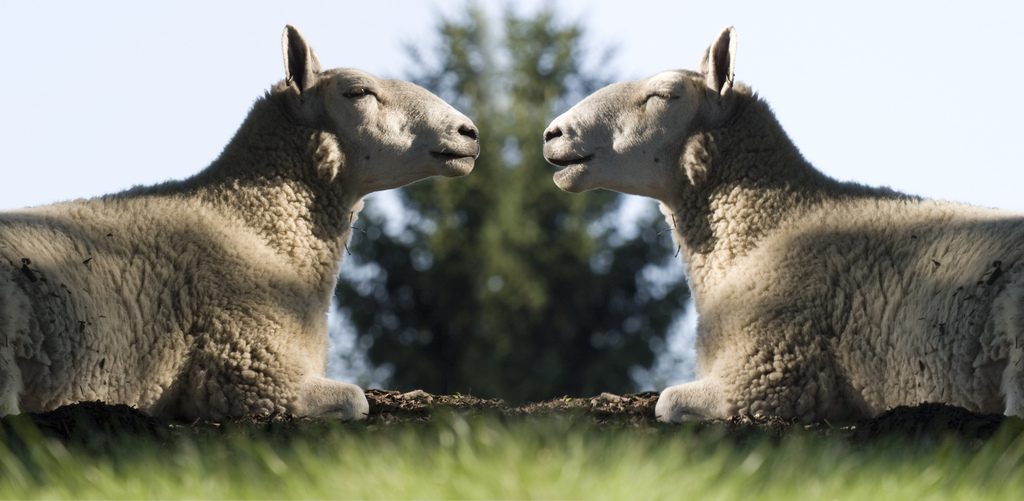Dolly is no doubt one of the most well-known sheep in the entire world. She has flipped the whole science world on its head and made scientists question the boundaries that they had never dared to try and pass. Her birth brought about a new era in the world of science, and with it many challenges and further discoveries. In the early 1900s, the idea of cloning was barely even a thought. Scientists had experimented with the cloning of younger animals, where they had experienced limited success, but they had set a new goal in which to learn how to clone an adult mammal. This task was seen as somewhat fantastical and hopelessly out of reach with the technologies of the time, if even possible at all. Several attempts had been made, and small discoveries slowly began to trickle into the scientific world, but it wasn’t until 1935 that one man’s crazy ideas got some serious recognition.
Hans Spemann, a German experimental embryologist, worked for years to develop what he came to coin “The Organizer Effect.” In his many experiments with the epidermis, eyeballs, and embryos of amphibians, he came to discover that a cell extracted from one animal and injected into the cell of another can influence the way that the recipient animal develops. Spemann tested his theory on a simple tadpole, and his result was, of course, another tadpole, but with an astounding two heads! He described this concept of one cell influencing the growth of another as induction. Spemann’s theory of induction was groundbreaking and led scientists to ponder whether or not extracting the nucleus from the cells would have the same result. This nuclear transfer is used in the current cloning process, and without Spemann’s foundational ideas, it would have been difficult for scientists to progress as quickly as they have been. The cell in which the new cell is introduced is what is know as “the organizer” because it is able to restructure the information that was already in the cell in the first place. After long hours of extensive research in Germany, and the onlooking pressure from fellow scientists, Spemann’s work finally got the attention it deserved. He was awarded the Nobel Peace Prize in 1935 for his discoveries, and his work became very influential in his field of study.1
For a little over fifty years, the cloning scene laid low. There were no more major advancements like those of Spemann in the early 1900s. That is, until biologist Keith Campbell and embryologist Ian Wilmut came along. In 1996, the two scientists began their work at the Roslin Institute in Scotland, where they based their research and lab procedures on the Nobel Prize winning ideas of Hans Spemann, and his induction and cloning mammal research.2

As cloning research began to increase, many scientists, and others, began raising ethical concerns about where this research was heading. Scientists began to predict where the industry could go in the future and the effect that it could have not only on animals, but on humans as well. While cloning did seem promising at its early stages, scientists could not help but think of human cloning in the future and the major ethical concerns that would come along with it. The public’s ideas generally weren’t derived from a more positive view. In their minds, they saw “Designer Babies,” and imagined how the wealthy would soon be able to manipulate the gene structure of an embryo to produce a smarter, better-looking, more-talented child. As a result, the existing gap between the rich and the poor would become even more dramatic.3 Not only that, but it wasn’t long ago that the public witnessed the destructive tests and extensive research that went into cloning animals along with the countless failed attempts that resulted in mutations or death of the offspring. In the cloning of humans, scientists expected to see comparable results of mutation and death.4
Major figures in the 2000s voiced concerns on both sides of the cloning debate. Former First Lady, Nancy Reagan, was among the smaller group that was able to see the potential benefits that cloning offered the world, specifically in that cloning could help in the curing of currently terminal diseases. She said, “Science has presented us with a hope called stem cell research, which may provide our scientists with many answers that for so long have been beyond our grasp. I just don’t see how we can turn our backs on this.”5 On the other hand, President George W. Bush voiced the opposing view that had concerns about cloning and its uses. He addressed the issue saying, “Make no mistake, that a cluster of cells is the same way you and I… started our lives. One goes with a heavy heart if we use these [embryonic cells]… because we are dealing with the seeds of the next generation…I believe all human cloning is wrong, and both forms of cloning ought to be banned.”6 President Bush was concerned about the manipulation of the genetic code and the way that it could change the coming generation. The bold statements and opinions from political figures such as these had a major impact on the views of the general public, but the overwhelming disapproval of cloning made it even more difficult for scientists to develop an effective process.
While this broad disapproval of cloning clouded the efforts of scientists interested in researching cloning, Campbell and Wilmut continued their research in order to achieve their goal of cloning an adult animal. They employed a newly developed process called Somatic Cell Nuclear Transfer (SCNT), in which they extracted the nucleus of a single somatic cell, or an adult cell of an animal, from the animal they want to clone, and then inject it into the unfertilized egg of another cell with the nucleus removed. In 1997, the two scientists began the SCNT process with a cell from an adult female sheep. After a few days, they implanted the cell into another female sheep, hoping that the cell would be accepted in her system and that a birth from it would be successful. Without knowing whether or not they would be successful, and with 276 failures behind them, the chances looked slim, but they decided to give it a try and hope for the best.7

As can be expected, the world’s view of cloning was not more accepting as the experimentation continued. Many felt that something had to be done to stop these experiments from becoming accepted. One of the newest developments in the cloning world was chimeras, or organisms consisting of more than one set of genes. Chimeras are animals that have been experimented on and now contain some human DNA in their systems. One of the main reasons for this process is to test whether or not human diseases can be effectively cured or improved with experimental treatment options before they are released to the public for use. In this way, scientists are creating animals and changing them to have more human characteristics. A past member of the President’s Council on Bioethics, Alfonso Gomez-Lobo, commented on chimeras saying that they, “violate the sanctity of human life by mixing humans with animals,” and that, “What is essentially human is really debased.”8
In 2009, San Brownback and Mary Landrieu, two senators, attempted to introduce a law that would completely stop the chimera testing processes all together. The supporting views of the public against chimeras gave the two a strong backing, and they hoped to bring about a drastic change. To stop what they deemed an immoral practice, they decided to create and propose a law to Congress that would prohibit all further testing similar to those of the chimeras. Although they had support, their law was never passed, but they are hopeful that it will be reconsidered at some point in the future.9
With the continuing turmoil, Wilmut and Campbell waited anxiously to see if their SCNT test on the female sheep would turn out to be a success. Everything seemed to be against them, but luckily enough, science was on their side. On July 5, 1996, their troubles were turned into triumph with the birth of a new baby sheep. Named after famous country singer Dolly Parton, Dolly the Sheep became the first mammal ever to be cloned from the cell of an adult animal.10 While the cloning was effective, the scientists were hesitant to share their results, in fear that Dolly’s life would be cut short due to some unforeseen problem in her production. Because of this, they waited almost an entire year, until, February 22, 1997, to announce the results of their tests. After the announcement, the news spread quickly. Dolly was featured in the Times and Science magazines, and she earned a sort of recognition that made her known all around the world.11

While many people emphasize the negative results of cloning, there are potential benefits as well. Scientists have suggested, for example, that the organs of pigs are compatible to those of human beings. This means that their organs could be harvested for therapeutic use in humans.12 Another area in which scientists have continued their research is in that of gene therapy, in which they use stem cells to control diseases like Parkinson’s and diabetes. While cloning doesn’t cure the disease, it can help to control it in both current and future generations.13 Along with the possibility of saving people’s lives, cloning can also help to save an entire species of animals. By taking the genes and DNA from an endangered species, scientists can have the species live on forever. Also, being that the cloning process doesn’t require a male and a female, it is more reliable in the case that one of the two dies out.14 In light of all of this research, most people see only a fine line between the scientific and religious obligations that come along with the cloning process. While cloning may be able to help cure diseases and save lives, it can also be manipulated and result in the destruction of life through the many experimental tests that are required for success.
Incredibly, Dolly the Sheep lived to be almost six and a half years with a reputation like no other. During this time, she broke the boundaries of what scientists had known and had come to expect, and she set the limit high for all those scientists to follow in the future. As Dolly became older, so did her frame and her health and she began to deteriorate. She developed arthritis and a form of lung cancer, and, in the end, she had to be put down. Even though she’s gone now, Dolly will continue to be remembered and her impact will always be felt forever around the world.
- Encyclopedia of World Biography, 2004, “Hans Spemann.” ↵
- Anna Marie Eleanor Ross, Scientific Thought: In Context (Detroit: Gale, 2009), 527. ↵
- Tina Kafka, Cloning (Detroit: Lucent Books, 2008), 78. ↵
- Barbara Wexler, Genetics and Genetic Engineering (Detroit: Gale, 2014), 135. ↵
- Carla Mooney, Bioethics (Detroit: Lucent Books, 2009), 81. ↵
- Carla Mooney, Bioethics (Detroit: Lucent Books, 2009), 88; Melissa Abramovitz, Stem Cells (Detroit: Lucent Books, 2012), 75. ↵
- Biotechnology: Changing Life Through Science, 2007, s.v. “Animal Cloning.” ↵
- Melissa Abramovitz, Stem Cells (Detroit: Lucent Books, 2012), 72-73, 75. ↵
- Melissa Abramovitz, Stem Cells (Detroit: Lucent Books, 2012), 76. ↵
- Encyclopedia of Science, Technology, and Ethics, 2005, s.v. “Human Cloning,” by Glenn McGee. ↵
- Encyclopedia of Science and Technology Communication, 2010, s.v. “Cloning,” by Rödder, Simone. ↵
- Richard Gray, Roger Dobson, and Kenneth Travis LaPensee, Biotechnology: In Context (Detroit: Gale, 2012), 247. ↵
- Kate Sampsell, History Behind the Headlines: The Origins of Conflicts Worldwide (Detroit: Gale, 2003), 78. ↵
- Environmental Encyclopedia, 2011, s.v. “Cloning,” by Ken R. Wells. ↵



77 comments
Alex Trevino
I remember hearing about Dolly the sheep when she was originally revealed, and I for one was astounded by the growth of science where we can do such a thing. My favorite part about Dolly has to be the reason behind her name, not only named after the country singer Dolly Parton, but the specific body part she was cloned from also influenced her name, and without naming it, I’m sure most can figure it out. This article was a real refresher for those into major advancements in science.
Franchesca Baldwin
I remember hearing about cloning sheep when I was a kid, and it was fascinating to read more in-depth about it. I surprisingly enjoyed learning somewhat about the molecular process, but it also brings up the idea of ethical practices in doing these sort of experiments and the possible repercussions that could occur. It’s an important conversation to have, and I’m glad to see it’s starting to be brought up.
Saira Locke
I’ve never been the person to know a whole lot about the whole thing of cloning, but after reading this article it has made it clear to me that it is very interesting. I don’t really love the idea of it at all because it makes it where almost every animal or even person is the same in a way. I like it better how everyone is different in there own way.
Nicholas Robitille
Cloning is a very controversial science with many different problems. It combines the question of if it is unethical to make a clone of something and play god with the question of genetically engineering better people being an unethical possibility with the science. Even if these are problems that the scientific community needs to address, no one can question that this is truly a scientific breakthrough.
Kasandra Ramirez Ferrer
I learned about cloning when I was in 2nd grade on my natural science class and I knew it was about how medicine had successfully cloned a sheep. They taught us about their molecules just like the picture on the article shows, growing up it was the only cloning thing I heard of until I read this article but scientist obviously didn’t stop after the sheep and continued cloning other animals. I think it’s an amazing discovery and believe that it will help medicine in the future to maybe the possibility to clone humans.
Mara Martinez
I didn’t even know about Dolly the Sheep and that she was cloned. How interesting and crazy. I knew about the cloned calves, and within the horse world cloned horses are becoming a large thing. I think it is amazing that people are now starting to follow through with this and think that it is okay. Which I don’t fully get but it’s alright. This was a very well written article!
Kimberly Parker
This article was very intriguing, to say the least. I mean the cloning of anything, just thinking about it, seems unnatural, and reading this article to find out that they were actually able to clone something, a sheep at that, just leaves me speechless. This article did a really good job though of showing both sides of the argument that is cloning. It gives more than just one point of view, which allows the reader to be able to come to their own conclusions, instead of just having to go off only one point of view.
Michael Lazcano
The implications of cloning within medicine is yet to be determined, but the cloning of whole organisms is baffling to say the least. While some people don’t agree with the experiment itself due to the ethical dilemmas it poses, I think this is one of the most important breakthroughs in modern science. If we can clone a sheep it really opens the door to even larger organisms in the future, and possibly humans. Something that seemed like science fiction could become reality in maybe five to ten years. While the ramifications of cloning isn’t exactly clear, it’s only a matter of time til it becomes more prevalent.
Bruno Lezama
I have heard of this experiment before when I was in High School; however, this is the first time I have read about the arguments that cloning has. On one hand, this experiment with the sheep helped a lot to the medicine to understand more how we can manipulate DNA in order to improve the quality of our life. On the other hand, the cloning of this sheep had some ethical problems that are controversial. Great Article!
Jake Mares
Interesting article! Thinking ahead, as stated, the use of cloning organs for transplants could make way for huge progress int hat department. While some see it as unnatural, the usefulness of these methods cannot be denied. Personally, I think Dolly is just the beginning as I believe cloning will keep becoming more prevalent with the times to come.